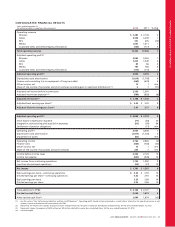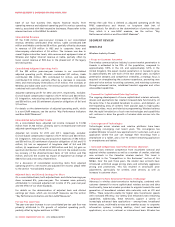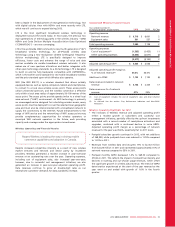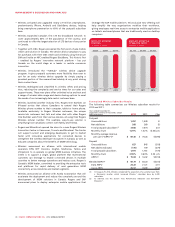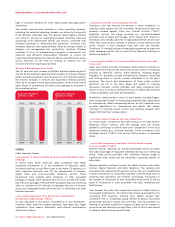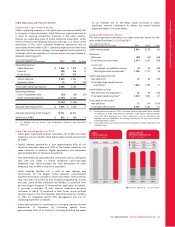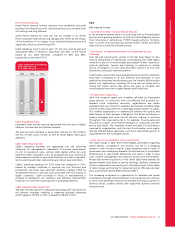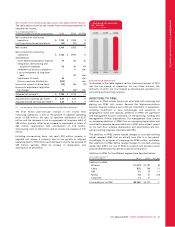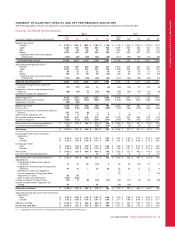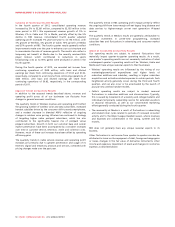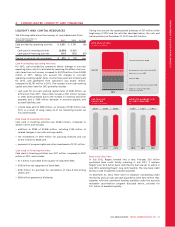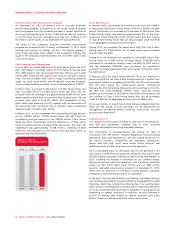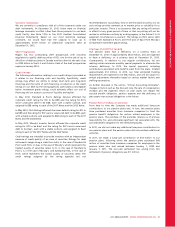Rogers 2012 Annual Report Download - page 47
Download and view the complete annual report
Please find page 47 of the 2012 Rogers annual report below. You can navigate through the pages in the report by either clicking on the pages listed below, or by using the keyword search tool below to find specific information within the annual report.
MANAGEMENT’S DISCUSSION AND ANALYSIS
MEDIA
Media Industry Trends
> Increased Competition
The Canadian media industry is highly-competitive, with a small
number of competitors having significant scale and financial
resources. In recent years, there has been increased consolidation of
traditional media assets across the Canadian media landscape. The
majority of players have become more vertically integrated to better
enable the acquisition and monetization of premium content.
Consumers have also been shifting their media consumption towards
digital media, mobile device usage and on-demand content. This has
caused new business models to emerge and advertisers to shift
portions of their spending to digital platforms.
Media’s ongoing success depends, among other things, on its ability
to secure popular broadcasting programs and content at favourable
prices; to maintain its high distribution level within the publishing
industry; to leverage its premium content, brands and capabilities
across multiple platforms; to adapt to and participate in the shift
towards digital advertising; and to leverage its leadership in sports
broadcasting.
The Canadian retail industry is inherently cyclical and subject to
recessionary pressures. Media’s televised shopping network faces
direct competition with traditional retail stores, catalogue retailers,
Internet retailers, direct marketing retailers, mail order companies
and other discount retailers. There is also a rapidly growing consumer
trend towards online shopping, which has been a historic strength of
Media’s televised shopping network. A rising number of traditional
retailers now offer online shopping options, further intensifying
competition in the sector.
The success of the Sports Entertainment business depends heavily on
team performance and fan-based loyalty. Media competes with other
professional league teams for fan-base and audience.
Media Operating and Financial Results
Summarized Media Financial Results
The following table summarizes Media’s financial results in the years
ended December 31, 2012 and 2011.
Years ended December 31,
(In millions of dollars, except margin) 2012 2011 % Chg
Operating revenue $ 1,620 $ 1,611 1
Operating expenses (1,430) (1,431) –
Adjusted operating profit(1) $ 190 $ 180 6
Adjusted operating profit margin(1) 11.7% 11.2%
Additions to PP&E $55$ 61 (10)
(1) As defined. See the section “Key Performance Indicators and Non-GAAP
Measures”.
Media Operating Highlights for 2012
• Media launched the City Saskatchewan television station following
the acquisition of Saskatchewan Communications Network,
marking another step in City’s geographic expansion towards a
national footprint. Media also announced that City and Jim
Pattison Broadcast Group signed long-term affiliate agreements
that will deliver City programming to audiences on all three of
Pattison’s television stations in western Canada.
• On February 4, 2013, Media closed the agreement to acquire Metro
14 Montreal and the station was relaunched as City Montreal,
which will enable the further expansion of the City broadcast TV
network into the largest portion of the Quebec market. With the
acquisitions and agreements put in place during 2012, City’s reach
has increased by more than 20% to over 80% of Canadian
households.
• Media closed the acquisition of theScore Television Network and
related television assets into a trust pending final approval from
the CRTC. theScore is a national specialty TV service that provides
sports news, information, highlights and live event programming.
It is Canada’s third-largest specialty sports channel with 6.6 million
television subscribers. The acquisition builds on Rogers’ rich history
in sports broadcasting and reinforces our commitment to delivering
premium sports content to audiences on their platform of choice.
Subject to final regulatory approval from the CRTC, which is
anticipated early in the first half of 2013, the television network
will be rebranded under the Sportsnet umbrella.
• Media advanced Rogers’ strategy of delivering highly sought-after
sports content anywhere, anytime, on any platform by
strengthening the value of its sports brand, Sportsnet, which is
further enhanced by Rogers’ 37.5% investment in MLSE.
• The Toronto Blue Jays made several off-season all-star calibre
player acquisitions and other moves that significantly boost the
team’s depth.
Media Revenue
Media’s revenue mainly consists of: (i) advertising revenue;
(ii) circulation revenue; (iii) subscription revenue; (iv) retail product
sales; and (v) ticket sales, receipts of MLB revenue sharing and
concession sales associated with Rogers Sports Entertainment.
Media’s revenue increased modestly from 2011, primarily driven by
revenue growth in our sports properties. Subscription revenue
increased by 10% due to the strength of the Sportsnet franchise and
overall distribution growth on our other specialty channels. In
addition, revenue in Sports Entertainment grew 17% as a result of
increased revenue related to the Toronto Blue Jays and successful
events at the Rogers Centre. These increases were partially offset by a
continued slow-growing advertising market across most industry
sectors in the face of economic softness and global uncertainty that
created ongoing volatility in advertising spending, as well as
advertising declines in the later part of the year associated with the
recently concluded NHL player lockout.
(In millions of dollars)
MEDIA REVENUE
$1,461 $1,611 $1,620
2010 2011 2012
2012 ANNUAL REPORT ROGERS COMMUNICATIONS INC. 43


